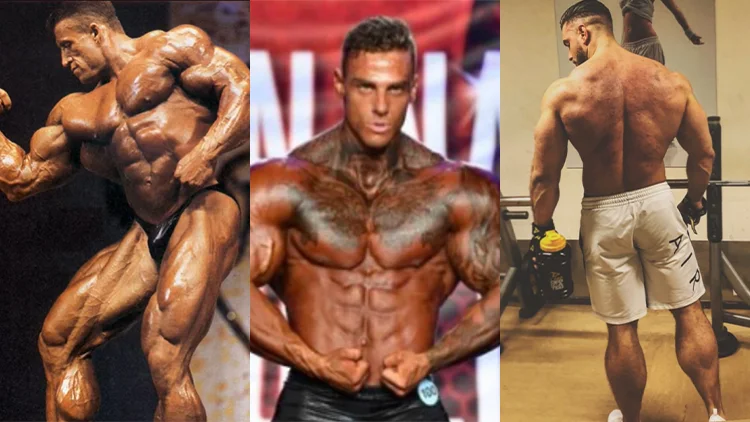
Indicators of bad bodybuilding genetics can range from less than desirable insertion points, symmetry, proportions, and more but contrary to popular believe, it’s not a big deal and there are plenty of professional bodybuilders with some form of bad genetics.1, 2, 3
Which goes to say, poor muscle genetics may be noticeable to you but the untrained eye wouldn’t think twice about a 4 pack or crooked abs if they’re visible and the rest of the body is muscular.
While you have no control over your genetics, you do have control over how hard you work inside and outside of the gym so some of these points can be mitigated with persistence.
So if you’re trying to determine if you have bad genetics when it comes to your physique, whether that’s your biceps, lats, triceps, chest, legs, or shoulders, see the tests below to determine if you have bad or good muscle genetics and what you can do about it.
What Are Poor Muscle Genetics?
Poor muscle genetics tends to be a subjective description of negative traits in the genes when it comes to bodybuilding; some may consider it the inability and/or difficulty to develop muscle at a considerable rate. It may also mean a lack of aesthetic symmetry and appeal when the muscles are grown and developed.
Characteristics and Traits of Poor Muscle Genetics & Bad Bodybuilding Genetics
Bad bodybuilding genetics manifests in different ways and factors including having bad insertion points, lower number of muscle fibers or in some cases appearing asymmetrical.
Insertion Points—Muscles have two ends that attach to bone, with one being the origin of the muscle, and the other being the insertion. Both these points have the tendons connecting them to the bone. Insertion points essentially refers to the muscle’s distal attachment (the furthest the muscle is away from the torso). To put this into perspective, the biceps muscle insertion point is at the elbow.
Symmetry—Some muscles may be asymmetrical due to having bad insertion points. A case in point is those with poor ab genetics who may not have symmetrical ‘blocky’ 6 pack muscles that are aligned.
Muscle Belly Size—Muscle belly is the base of the muscle where all the tendons meet and attach; sometimes referred to as muscle insertion points and is essentially the total number of muscle fibers present in the muscle.4 The length of the muscle belly is what makes it either a good genetic trait or not.
Longer muscle bellies means that a bodybuilder has more ‘space’ to work with and therefore can easily grow bigger muscles; shorter muscle bellies are undesired.
Overall Number of Muscle Fibers—The number of muscle fibers has a direct relation in the ability to grow muscle. A study for example counted the number of muscle fibers of men ranging from ages 15-22 and found a range of over 390,000 to almost a million fibers in quadriceps muscles.5
Human muscle fibers are a complex, multifaceted area of anatomy with huge ramifications for a person’s performance and ability to achieve superior hypertrophy (muscle growth) rates.6
Types of Muscle Fibers—Muscles are broadly composed of two different types of fibers: fast twitch (type 2) fibers that are typically thicker, and slow twitch (type 1) fibers that are thinner. The fast twitch fibers are more suited to high intensity bursts of energy but tire quickly; while the slower twitch fibers are not that energy intensive but have longer endurance and are less responsive to strength training.
Ratio differences of these fibers vary significantly in individuals and the presence of varying proportions of these fibers in individuals has major implications in strength training and sports.
Difficult To Grow—Poor muscle genetics can mean more than their aesthetic appearance.
For example, if someone trains with enough volume and intensity for months to years on top of ensuring their macronutrients, specifically protein, were on point and they’ve gone through a few bulks with little to no progress then it may be a sign that their genetics for that particular muscle group are lackluster.
If this is the case, the only solution is to hit all heads of the target muscle more by increasing the volume and using the right exercises alongside a strong focus on nutrition.
Structure of Bones—The shape of the bones will directly have an effect on how the muscle will appear. Abnormalities in the sternum (t-shaped bone on the chest) for example, may cause it to grow inwards; as a result, chest muscles may have a sunken appearance.
How To Know If You Have Poor Muscle Genetics or Bad Bodybuilding Genetics (Ways To Empirically Measure Genetic Predisposition & Lean Body Mass)
Finding out if suboptimal bodybuilding genetics or having lackluster muscle genetics is the first step to pinpointing if genes are the culprit for lackluster performance—fortunately, other than monitoring growth and aesthetics markers seen above, there are a number of ways to empirically gather this information and test for every muscle group.
These include using a DEXA scan and/or tape measure, DNA testing and establishing insertion points.
Dexa Scan & Tape Measure
A DEXA scan (bone density scan) uses x-rays to measure the bone density and can also be used to determine and provide an accurate analysis of fat tissues, lean body mass and skeletal muscle mass.
In addition, using a simple tool such as a tape measure can provide an accurate way for lifters to make a determination of symmetry and proportion in body parts by measuring their circumferences.
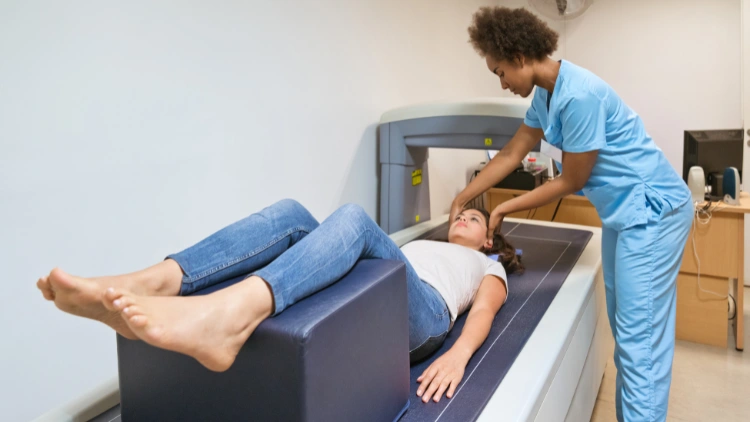
Source: izusek via Canva.com7
Physically Inspecting the Body for Insertion Points
Biceps and calves best manifest the effect insertion points have on muscles. For example, lifters can easily and accurately determine the insertions of their biceps.
They do this by flexing their biceps such that the upper arm and forearm form a right angle. If there is a lot of distance between the bicep and the elbow, then these are short muscle bellies and they therefore don’t possess desirable biceps genetics. If the bicep is jammed up to the elbow joint, they have excellent bicep genetics.
Using Genetic Formulas (Dr. Casey Butt’s Formula, Martin Berkhan’s Formula)
These two formulas could give individuals some idea of what their expectation and estimate of the circumference of muscle size that can be at its maximum based on genetics.
Dr. Casey Butt’s formula takes into consideration a person’s wrist and ankle size where the breadth of a wrist provides key information to frame size, fat and muscle content regardless of stature. Martin Berkhan’s Formula provides an upper weight limit using the height, aspects of training, their diet and lifestyles in this order.
DNA Testing
Lifters can also use lifestyle genetic tests that are affordable and have become popular thanks to their ease of use.
Advances in DNA technology inform the donor what their strengths and weaknesses are in reference to strength training, building muscle and even allow for nutrition planning. These DNA results can therefore provide a guide post to allow lifters to program their routines to extract maximum benefits from strength training.
Providers that offer these services include Helix, DNAfit and Cross DNA. Individuals interested have a kit sent out to them in which they provide a sample, usually saliva. This is then mailed back, analyzed and the company sends back the results. Most providers charge under $300 for a DNA test.
These DNA tests typically test for the presence of two candidate genes known as the ACTN3 (Alpha-actinin-3 or alpha-actinin skeletal muscle isoform 3) and ACE gene.
These two genes are associated with superior physical performance—there is a link between these genes in elite powerlifting and sprinting with lower injury risk and faster recovery times.
Poor Muscle Genetics & Bad Bodybuilding Genetics by Body Part (Examples, Pictures & Descriptions)
Bad bodybuilding genetics and Poor muscle genetics can be spotted on different body parts whether it be the legs, pecs and abs. The descriptions below delve into the different muscles and what to look for as features of bad genetics as well as pictures and examples.
Poor Chest Genetics (Poor Pec Genetics)
Poor chest genetics or poor pec genetics simply means that the chest muscles (pecs) do not respond well to strength training and are difficult to grow. There are a number of other characteristics to look for when individuals have poor pec genetics:
- There are gaps in the chest due to insertion points that are too far apart; it is impossible to fill these gaps since there is no muscle present at the sternum.
- There may be disproportionate distribution of fast and slow twitch muscle fibers which could lead the muscle to not respond well to training. This could also result in disproportionate lower to upper chest ratios.
- Nipple location may make the chest appear not full.
How to Check for Poor Chest Genetics—The first sign to check poor pec genetics is to determine the insertion points of the pecs. There should be very little gap between the pecs, if the space between the pecs is abnormally large, then someone has poor chest genetics. In addition, shorter clavicle lengths (shoulder blades) means chest muscle will be limited in how it can grow. Also if the upper or lower pec is hard to grow, then this means bad genetics are to blame.
Examples of bodybuilders with poor chest genetics showing uneven pecs, abnormal nipple location and a chest gap (in order) appear below.
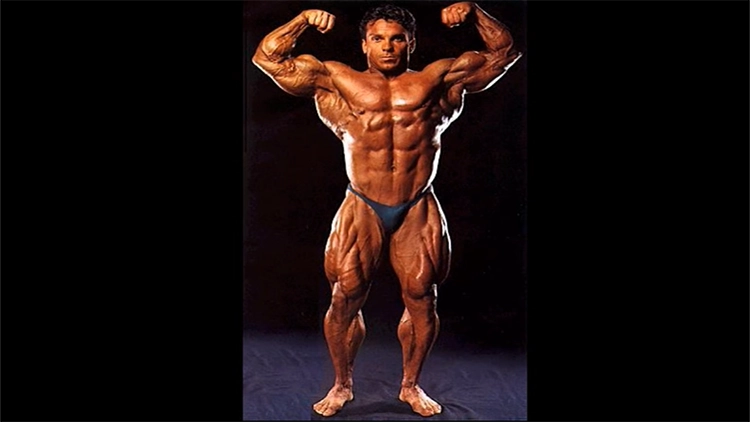
Rich’s chest genetics are visibly not optimal, as shown by his right nipple that appears detached from his pec muscles and the asymmetry between his lower left pec and right one. Source: Tomn8er on Youtube
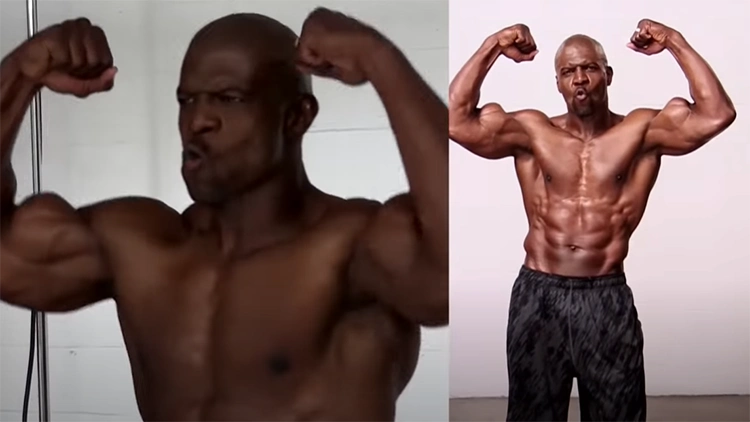
The visible gap between Terry Crews’ pecs is a clear indication of poor chest genetics, with the insertion points being far apart and contributing to the difficulty of developing a fully formed chest. Source: Muscle and Fitness on Youtube8
Poor Shoulder Genetics
Another body part that is prone to being affected by genetics are the shoulders which also happen to be one the hardest muscle to grow. They are also one the biggest contributors to the coveted v-taper shape, and cannonball shoulders are always a desirable trait to have.
There are a number of physical descriptors that can point to a lifter that has poor shoulder genetics. These include having short muscle bellies and generally uneven shoulder muscles.
Short Muscle Belly—Lifters with short muscle belly simply do not have enough muscle fibers in their shoulder muscles due to having relatively long tendons. As a consequence, they may find it difficult to grow their shoulders or have a maximum size for which their shoulders may grow.
Uneven and Smaller Shoulder Muscles—Individuals with smaller shoulder muscles that may be uneven is a sign of poor shoulder genetics. These lifters may have a shoulder that is typically weaker compared to the other one and is always pain prone.
Small Skeletal Size and Bone Density—Smaller skeletal structures, bones and joints will make the shoulder muscles harder to train and grow muscle.
How to Check for Poor Shoulder Genetics—This can be done by easily inspecting the shoulder muscles. Flex the shoulder muscles and determine if there is discrepancy in sizes between all the deltoids heads. Smaller shoulder muscles that are uneven and not symmetrical with each other are an indication of poor shoulder genetics.
Here is an example of what poor shoulder genetics may look like. This individual’s shoulders have a presence when viewed from the side. However, in the picture that follows when viewed from the front, the muscles seem to almost disappear. This means he does not have proportional muscle bellies across all heads.
Poor Lat Genetics
The lats occupy the largest area of the upper back extending from the shoulder blades to the lower part of the back. Poor lat genetics are typically as a result of having high insertion points famously known in the bodybuilding world as a “palm tree”.
While the v-taper may appear quite drastic, there is a thickness that is lacking. As with other bad body parts, there is nothing lifters can do about this except work the lower lats and squeeze the most out of them.
How to Check for Poor Lat Genetics—Individuals with high lat insertion points may have a v-taper look, however, they find it difficult to grow thick back muscles compared to those with low insertion points.
Lee Priest, who is a famous bodybuilder, has high lat inserts as seen in the image below. His back still looks impressive showing the v-taper look, but is lacking in thickness in the bottom portion since his lats insert so high.
Poor Ab Genetics
Genetics have a significant part to play in whether someone can have aesthetically pleasing abs, or even abs that are visible for that matter. Abs are a very desirable body part to have—everyone wants to have chiseled and symmetrical abs; for many, even more than having a bodybuilding physique. This goes for both men and women.
Signs to look for when somebody has poor ab genetics are uneven abs, having narrow abs due to insertion points and having a layer of fat covering the abdominals.
Asymmetrical and Uneven Abs—The bands of connective tissue are configured in such a way that the segments don’t line up giving the abs an uneven and asymmetrical appearance. This is in contrast to having them as aesthetically pleasing, well-arranged and symmetrical 6 pack abs.
Bad Insertion Points—Bad insertion points will result in a lot of room between the edge of their ribs and outside the abs. This means that there is not enough muscle leading to small abs.
Visibility and Fat Presence—Individuals with poor ab genetics will be prone to an abnormal distribution of fat cells around the abs. There may be uneven fat around the abs particularly above the rectus abdominis.
Number and Shape of Abs— The rectus abdominis is the primary muscle that gives the ‘blocky’ looks of the abs and is not divided into upper, middle, or lower abs—it appears this way due to the bands of connective tissue. These tissues are pulled tighter in some areas than in the rest, giving the appearance of divisions of specific muscles; however, it is all one muscle.
For a good chunk of the population, three intersections run down the rectus abdominis, thus leading to 6 pack abs.9 However, those with poor ab genetics will end up having less intersections leading to them having 2 or 4 pack abs as opposed to having the highly desired 6 pack abs.
How to Check for Poor Ab Genetics—Individuals can line up their fingers and physically check to see if the abs are symmetrical. Alternatively, by reducing the overall body fat percentage to below 20%, it will be easier to determine the size and arrangement of the abs.
Below are samples of individuals with poor ab genetics showing uneven abs and fat that is hiding the abs.
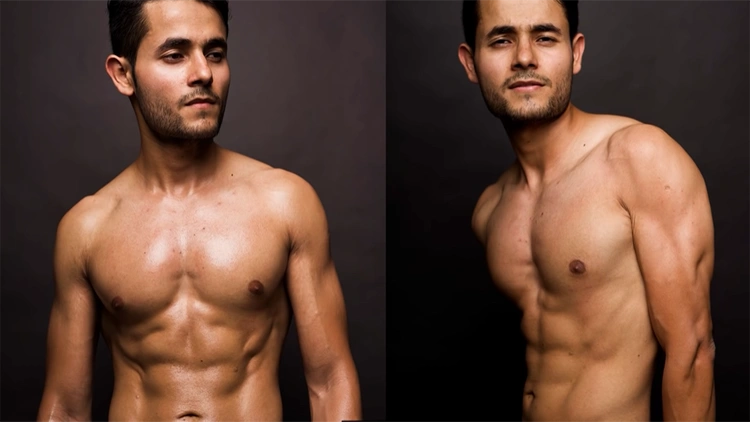
Notice how only two abs are visible while he is flexing in front view and side view. Source: Hypertroph on Youtube10
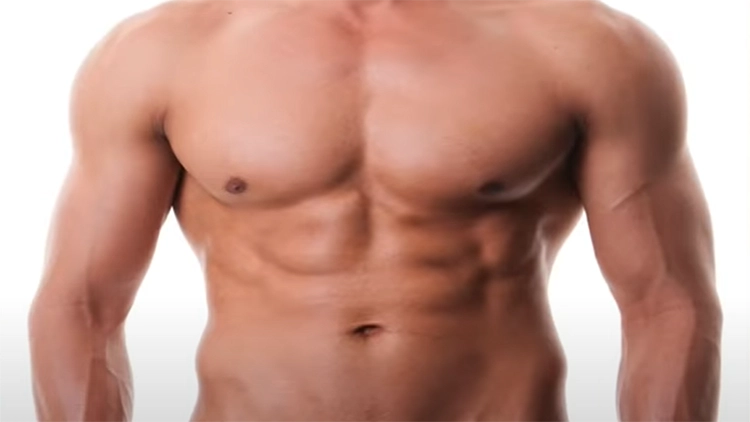
See how his abs are barely visible due to the fat over it. Source: Jeremy Ethier on Youtube11
Poor Leg Genetics
There are 3 key concepts that construe what it means to have poor leg genetics for bodybuilding; these are high insertions and high ratios of slow-twitch to fast-twitch muscles.
High Insertions and Muscle Bellies—Insertions will make a determination as to how long the leg muscles (calves, quads and hamstrings) are; which essentially determines the length of the muscle bellies. The most important muscle insertion is that of the gastrocnemius (main calf muscle) which has an insertion that originates behind the knee and terminates somewhere from one-third to two-thirds of the way down to the ankle.
When the insertion is low, the thicker the muscle belly. However, high insertions will lead to more lopsided bulgy and skinny lower calves. The same goes with quads that have high insertions resulting in the muscles stopping well above the knee and then turning sharply inward, instead of sloping down closer to the knee.
Having a High Ratio of Slow-Twitch to Fast-Twitch Muscles—Slow twitch have incredible endurance but are much harder to grow than fast twitch fibers . There are varying ratios of these types of muscles in individuals.
Whether a person’s leg genetics are ideal for bodybuilding or not, though, the soleus and gastrocnemius (calf muscles) have astronomical levels of type I muscle fibers.12 Studies have shown that individuals that partake in elite powerlifting and bodybuilders have naturally high levels of Type II muscle fibers.
How to Check for Poor Leg Genetics—Start at a full stretch at the bottom, and pause for a second while pulling down further with the tibiae. Push up onto tippy toes and hold for one second, and that should flex the muscles enough to make the insertions clear and visible and make a determination if the insertion points are high or not.
Below are some examples of poor leg genetics showing high insertion points for the calves and quads respectively.

Notice how his calves are thinner in comparison to the rest of his body. Source: ryanmurdochfit on TikTok13
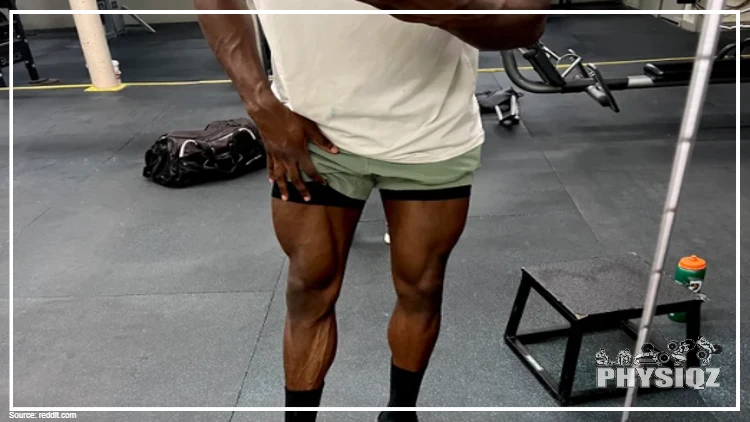
It’s noticeable that his quads are well-developed, although the insertions are quite high. Source: u/themodernronin on Reddit14
Bad Triceps Genetics
Poor triceps genetics is a hotly debated phenomena that revolves mostly around the insertion points of the triceps muscles. A high triceps insertion means that the triceps muscle inserts higher up on the humerus (upper arm bone) than normal. This means that while the overall triceps will have a higher peak than someone with a low triceps insertion, it will look significantly less ‘full’ than individuals with a low triceps insertion.
There is no way to change insertion points. It is therefore important to focus on exercises that target the long head (triceps brachii) of the muscle since it is responsible for most of the size and strength.15
How to Check for Bad Triceps Genetics—To determine whether the lifter has bad triceps genetics, straighten the arm and with the left arm, take 3 fingers (pointer, middle and ring fingers) and place them on the backside of the arm under the long head. The pointer finger should be at the end of the elbow and if the insertion point of the long head is more than 3 fingers from the elbow, this would be a confirmation of bad triceps genetics.
Here are some examples of bad triceps genetics showing triceps with short muscle bellies.

Take note of where his triceps end (where the red arrows point to) and the tips of his elbows (in red circles). Source: @kingkamali on Instagram16
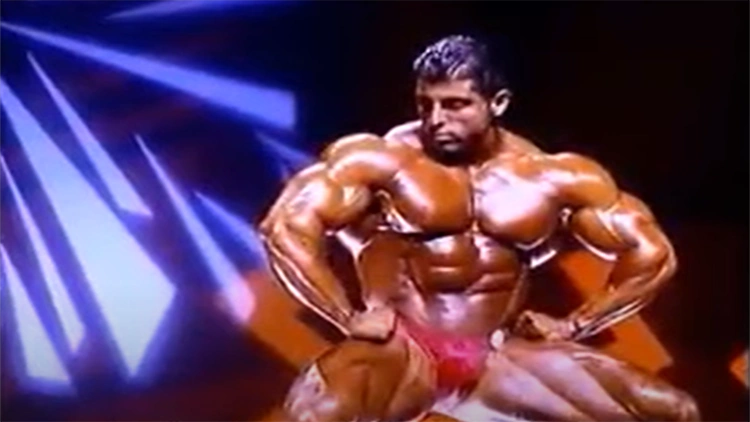
Although he has small tricep bellies, Kamali’s overall physique is impressive due to his hard work and determination. Source: Michael Diamond Bodybuilding on Youtube17
Poor Bicep Genetics
Having big guns is every lifter’s dream and having poor bicep genetics can put a real damper on that dream. There are primarily two reasons and ways in which poor biceps genetics may be apparent in lifters and this is due mainly to insertion points and having no and/or uneven bicep peak.
Insertion Points— A high bicep insertion is when the biceps muscle attaches higher up on the arm and closer to the shoulder. This is considered poor bicep genetics because it makes it harder for the biceps to contract efficiently resulting in smaller, less full biceps that are located further away from the elbow.

Take note of where his bicep ends and the vast distance from his elbow. Source: luimarco on Youtube18
No or Uneven Bicep Peak—Another poor bicep genetics is when biceps do not have defined ‘peaks’, or appear as a very flat, linear bicep without curves, or even have a peak that is off center.

Check out how the left bicep peak (his right arm) is much more sharp and defined than the right (his left arm). Source: luimarco on Youtube19
How to Check for Bad Biceps Genetics—To check for bad biceps genetics, flex the biceps such that the upper arm and forearm form a right angle. Check to see if fingers fit between elbow crease and elbow. The wider this space is, the greater likelihood for bad biceps genetics.
The images below show individuals with high insertion points and uneven bicep peaks.
Can I Build Muscle With Bad Genetics?
At the end of the day, lifters don’t have much say with what genetics they may or may not have for whatever body part. But they have a say in what they can do about it. This means they can and should engage in strength training programs to engage, activate, grow and strengthen their muscles both for the upper and lower body.
Lifters should strive to increase the training volume and frequency on the body part that is lacking to bring it up to speed and make the most of it.
Calculator To Check for Bodybuilding Genetics (FFMI Calculator)
There is a calculator that lifters can use to determine their genetic muscular potential and give them an idea if they have good bodybuilding genetics—this is known as the FFMI calculator (fat free mass index)20 It is based on Casey Butt’s work on researching elite and natural bodybuilders. However, it cannot be applied to lifters who are not lean.
This calculator will provide information pertaining to the relative development for men only, women receive estimates due to insufficient data. Lifters need a measurement tape to make use of the calculator.
Types of Good Muscle Genetics
A number of good muscle genetics occur in the body which makes it easier for lifters looking at getting stronger; these include the ACE gene, Vitamin D gene and testosterone genes. The full list of good muscle genetics include:
- Testosterone genes
- Vitamin D gene
- ACE and ACTN3 gene
- Myostatin gene
- Sprinter gene
How To Grow Muscle With Bad Genetics
Rather than focus on the different body types (mesomorph, ectomorph and endomorph) that they may belong to, lifters should focus on improving and enhancing their training— both during working out and when recovering to aid the muscles to grow. This includes increasing training volume, periodization and dieting well. Lifters with bad genetics should follow these cues:
- Increasing training volume and frequency critical to muscle and growth.21
- Incorporate daily undulating periodization programs where they are varying training variables such as frequency and volume to allow gains to continue.
- Employ workout routines that use compound movements in conjunction with isolation movements to target specific muscles.
- Proper rest between sets and workout days to allow for muscle recovery.
- Having good diets that have increased calories for energy and greater protein intake for muscle repair to promote hypertrophy.22
- Training with proper form and technique and not using too heavy weight (ego lifting).
It is clear that bad bodybuilding genetics has a profound impact on muscle development and appearance and that nothing much can be done to change a lifter’s genetic make-up—it is also possible for lifers to test for every muscle group and thus determine their genetic traits to establish their strengths and weaknesses and use this a blueprint to formulate a plan to train their muscles and make the best of what they have.
Frequently Asked Questions
What Race Has a Higher Percentage for Poor Muscle Genetics for Bodybuilding?
African Americans males and females have the highest percentage for mean skeletal muscle mass while Asian females and Hispanic males have the smallest skeletal mass as per a 2010 study based on subjects that were over 60 years old of which 468 were male and 1280 female adults.
What Are the Signs of Having Good Chest Genetics
Individuals with good chest genetics will tend to:
- Have longer clavicle (shoulder blades) lengths to accommodate bigger chest muscles.
- Symmetrical proportions of muscle in the lower and upper chest.
- Very small gaps between the pecs.
- Nipple location that gives the chest muscles appear full.
Are Wide Chest Muscles a Product of Good Genetics?
Yes, wide chest muscles are an indication that a lifter has long clavicles which implies that they have longer muscle bellies to grow wide chests.
Are Wide Shoulders a Good Sign for Good Genetics?
Yes, wide shoulders are a good sign of good genetics due to longer muscle bellies and having larger skeletal sizes and bone densities which are all positive traits.
Can Genetics Be Changed?
No, genetics cannot be changed as this is how individuals are born. However, lifters can work with what they have and still be successful bodybuilders.
How To Tell if You Have Good Bicep Genetics
The best way to tell if a lifter has good bicep genetics is simply by flexing their biceps such that the upper arm and forearm form a right angle to determine the distance between the bicep and the elbow. If the bicep is jammed up to the elbow, then the person has good bicep genetics. The biceps should also have even peaks.
What Are the Differences Between Good vs Bad Muscle Genetics?
Good muscle genetics make it easier to build muscle that is full and symmetrical while bad muscle genetics make it harder to build muscle. Also, many times bad muscle genetics will have imperfections such as asymmetry, gaps in the chest, asymmetrical abs and uneven biceps peaks.
References
1Top Bodybuilders Who Overcame “Bad” Genetics.” YouTube, 5 August 2017. Accessed 30 March 2023. <https://www.youtube.com/watch?v=BynHphf0BCo>
2JAY LISACEK (@jaylisacek) • Instagram photos and videos.” Instagram. Accessed 30 March 2023. <https://www.instagram.com/jaylisacek/>
3Rice, Damien, and Matt Galbraith. Reddit, 16 November 2008, Accessed 5 April 2023. <https://www.reddit.com/r/MensMuscleCalves/comments/arox5r/jelle_starreveld/>
4Institute, N. C. (2023). Structure of Skeletal Muscle. Retrieved 2023, from <https://training.seer.cancer.gov/anatomy/muscular/structure.html>
5Sander A. J. Verbrugge, M. S. (2018, May 22). Genes Whose Gain or Loss-Of-Function Increases Skeletal Muscle Mass in Mice: A Systematic Literature Review. Retrieved 2023, from <https://www.ncbi.nlm.nih.gov/pmc/articles/PMC5992403/>
6Daniel L. Plotkin, M. D. (2021, September 10). Muscle Fiber Type Transitions with Exercise Training: Shifting Perspectives. Retrieved 2023, from <https://www.ncbi.nlm.nih.gov/pmc/articles/PMC8473039/>
7izusek. Canva. Accessed 22 April 2023. <https://www.canva.com/photos/MAEI0yIMbUs-young-nurse-preparing-woman-for-bone-density-scan/>
8Behind The Scenes: Terry Crews is More Ripped Than Ever at 49.” YouTube, 30 July 2017. Accessed 30 March 2023. <https://www.youtube.com/watch?v=ZDgGriH6Vx4>
9Anita, M. H. (2015, June 1). Variation in Tendinous Intersections of Rectus Abdominis Muscle in North Indian Population with Clinical Implications. Retrieved 2023, from <https://www.ncbi.nlm.nih.gov/pmc/articles/PMC4525496/>
10How many WEEKS will it take to get SIX PACK Abs (EXACT FORMULA).” YouTube, 2 January 2021. Accessed 30 March 2023. <https://www.youtube.com/watch?v=NRl9uKhnEJ0>
11Uneven Abs: The 3 Main Types and How to Tell Which One You Have.” YouTube, 13 December 2011. Accessed 30 March 2023. <https://www.youtube.com/watch?v=joq7bWHGsSk&t>
12V R Edgerton, J. L. (1975, May). Muscle fibre type populations of human leg muscles. Retrieved 2023, from <https://pubmed.ncbi.nlm.nih.gov/123895/>
13Ryan Murdoch. “@ryanmurdochfit.” TikTok, Accessed 5 April 2023. <https://www.tiktok.com/@ryanmurdochfit>
14u/themodernronin. “High quad insertions might be the worst 🙁 : r/strength_training.” Reddit, 9 September 2022, Accessed 5 April 2023. <https://www.reddit.com/r/strength_training/comments/xa2776/high_quad_insertions_might_be_the_worst/>
15Norihide Sugisaki, T. W. (2015, April). Influence of muscle hypertrophy on the moment arm of the triceps brachii muscle. Retrieved 2023, from <https://pubmed.ncbi.nlm.nih.gov/25411895/>
16Shahriar King Kamali (@kingkamali) • Instagram photos and videos.” Instagram. Accessed 5 April 2023. <https://www.instagram.com/kingkamali/>
17“Posing-King Kamali.” Youtube, 16 November 2008. Accessed 5 April 2023. <https://www.youtube.com/watch?v=kfAnSVMk9dc>
18“The Biceps Peak, Genetic Or Not ?” YouTube, 24 November 2012. Accessed 5 April 2023. <https://www.youtube.com/watch?v=eOegIx5TeUY>
19“The BEST Biceps Exercise Ever.” YouTube, 13 February 2011. Accessed 5 April 2023. <https://www.youtube.com/watch?v=b88TXnwSZWQ>
20HR Hull, J. T.-S. (2010, June 8). Fat-free mass index: changes and race/ethnic differences in adulthood. Retrieved 2023, from <https://www.ncbi.nlm.nih.gov/pmc/articles/PMC3306818/>
21Eisuke Ochi, M. M. (2018, July 2). Higher Training Frequency Is Important for Gaining Muscular Strength Under Volume-Matched Training. Retrieved 2023, from <https://www.ncbi.nlm.nih.gov/pmc/articles/PMC6036131/>
22John W. Carbone, S. M. (2019, May 22). Dietary Protein and Muscle Mass: Translating Science to Application and Health Benefit. Retrieved 2023, from <https://www.ncbi.nlm.nih.gov/pmc/articles/PMC6566799/>